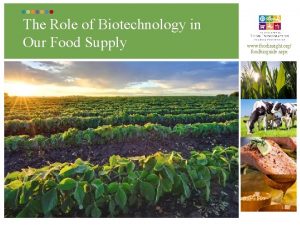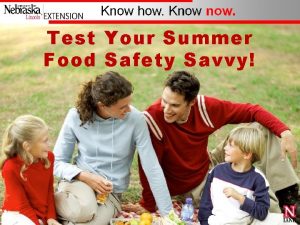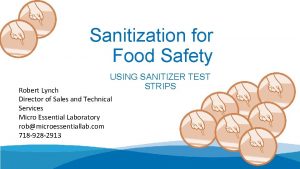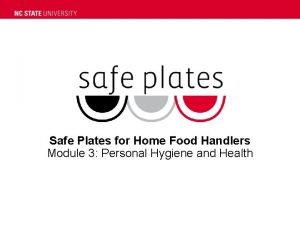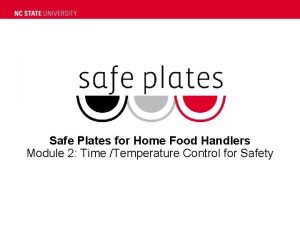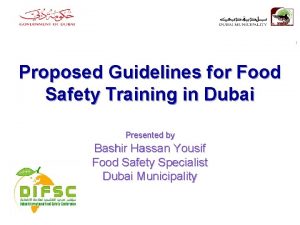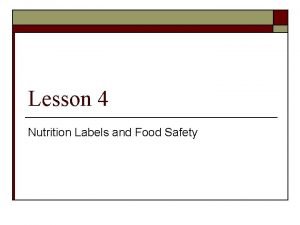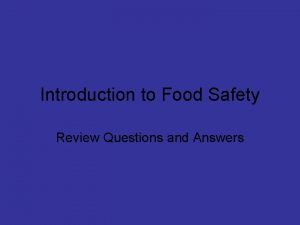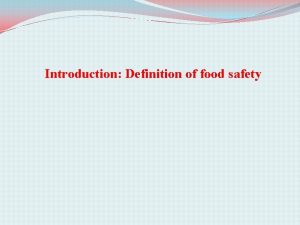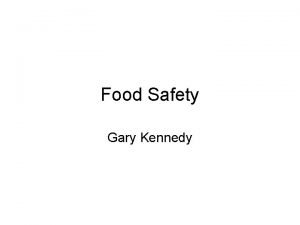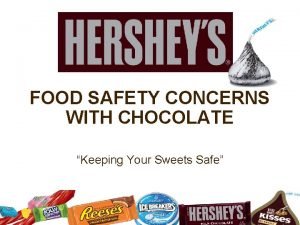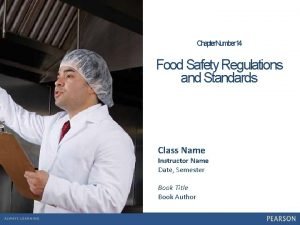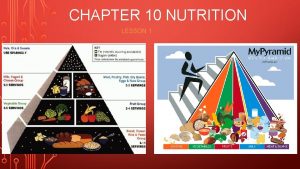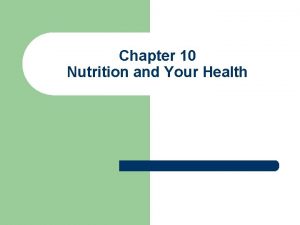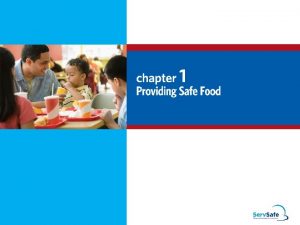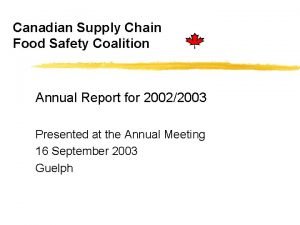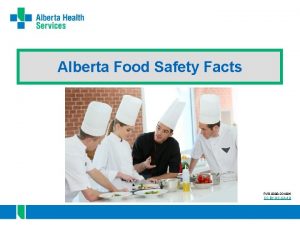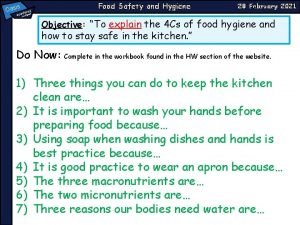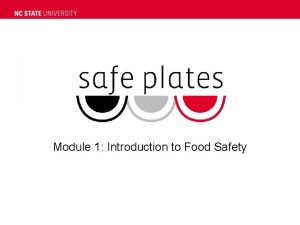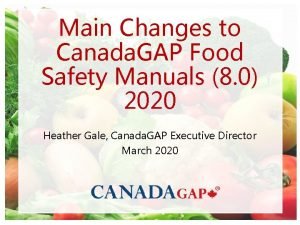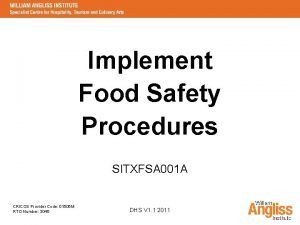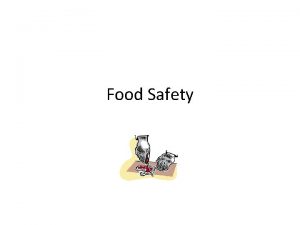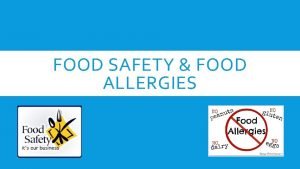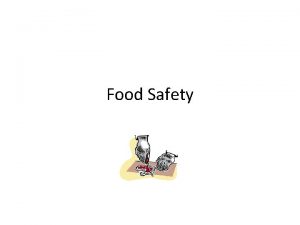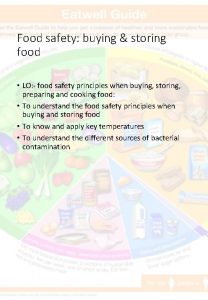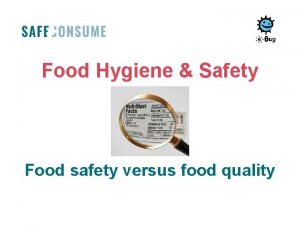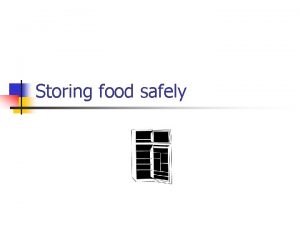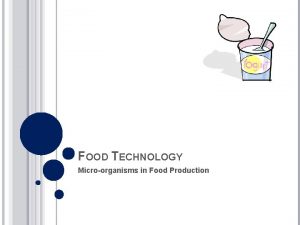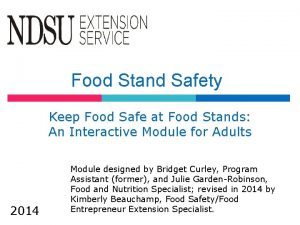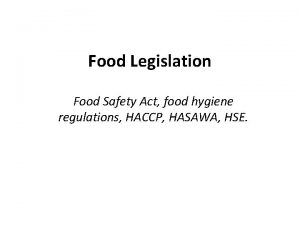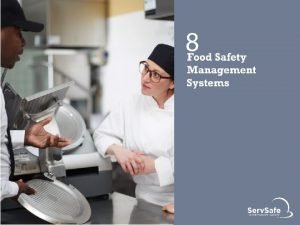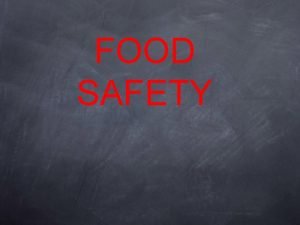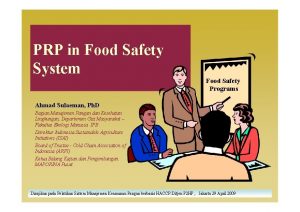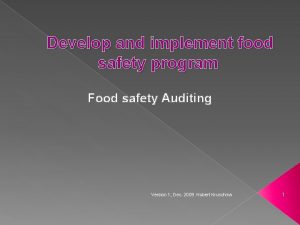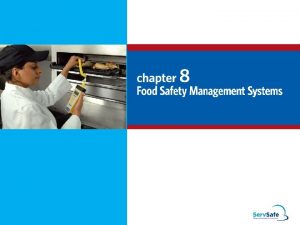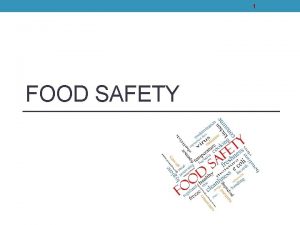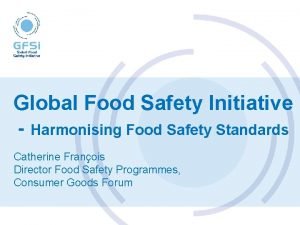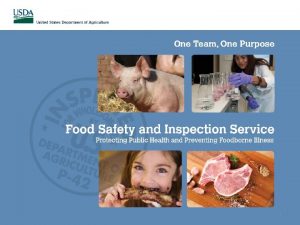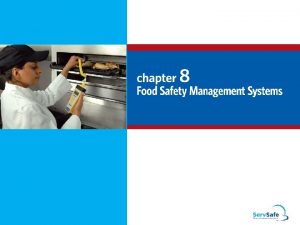Food safety What food safety is Food safety




![The five key principles of food hygiene, according to WHO, are: [2] ◦ Prevent The five key principles of food hygiene, according to WHO, are: [2] ◦ Prevent](https://slidetodoc.com/presentation_image_h/0a02bcf32336b209b58d1c53ea6e1202/image-5.jpg)


























- Slides: 31

Food safety

What food safety is? �Food safety is a scientific discipline describing handling, preparation, and storage of food in ways that prevent foodborne illness.

What foodborne illness is? �Foodborne illness is any illness resulting from the consumption of contaminated food, pathogenic bacteria, viruses, or parasites that contaminate food, [2] as well as chemical or natural toxins such as poisonous mushrooms.

�Food can transmit disease from person to person as well as serve as a growth medium for bacteria that can cause food poisoning. In developed countries there are intricate standards for food preparation, whereas in lesser developed countries the main issue is simply the availability of adequate safe water, which is usually a critical item. [1] In theory, food poisoning is 100% preventable.
![The five key principles of food hygiene according to WHO are 2 Prevent The five key principles of food hygiene, according to WHO, are: [2] ◦ Prevent](https://slidetodoc.com/presentation_image_h/0a02bcf32336b209b58d1c53ea6e1202/image-5.jpg)
The five key principles of food hygiene, according to WHO, are: [2] ◦ Prevent contaminating food with pathogens spreading from people, pets, and pests. ◦ Separate raw and cooked foods to prevent contaminating the cooked foods. ◦ Cook foods for the appropriate length of time and at the appropriate temperature to kill pathogens. ◦ Store food at the proper temperature. ◦ Do use safe water and raw materials.

World Health Organization �The World Health Organization (WHO) is a specialized agency of the United Nations (UN) that is concerned with international public health. � It was established on 7 April 1948, headquartered in Geneva, Switzerland,

�The parliament of the European Union (EU) makes legislation in the form of directives and regulations, many of which are mandatory for member states and which therefore must be incorporated into individual countries' national legislation. �As a very large organisation that exists to remove barriers to trade between member states, and into which individual member states have only a proportional influence, the outcome is often seen as an excessively bureaucratic 'one size fits all' approach

�Individual member states may also have other legislation and controls in respect of food safety, provided that they do not prevent trade with other states, and can differ considerably in their internal structures and approaches to the regulatory control of food safety. �From 13 December 2014, new legislation - the EU Food Information for Consumers Regulation 1169/2011 - require food businesses to provide allergy information on food sold unpackaged, in for example catering outlets, deli counters, bakeries and sandwich bars.

European Food Safety Authority (EFSA) The European Food Safety Authority (EFSA) is the keystone of European Union (EU) risk assessment regarding food and feed safety. In close collaboration with national authorities and in open consultation with its stakeholders, EFSA provides independent scientific advice and clear communication on existing and emerging risks.

Romania and food safety

Romania's potential to produce organic food is rising to the potential of Germany (the second biggest producer in Europe). Nevertheless, it remains untapped because of the too low demand from the population. So producers feel compelled to export raw materials from Western countries for processing and on the shelves of stores in Romania, products arrive at oversized prices. We wish that through this work to identify as accurately as possible the level of the supply and demand of organic food products in order to make proposals to improve the current situation, but in particular to improve the quality of life of the population of Romania, through its guidance to a healthier lifestyle.

Food Laws in Romania

�Romanian legislation in the food and agricultural sector, in general, is in line with the EU legislation �and applies to both domestic and imported products. Food products of US origin may enter directly into �Romania or indirectly, through other Member States. The customs procedure is applied at the first point �of entry into the EU-28

�The responsibilities related to food and agricultural products are shared among �several Governmental entities, listed below: �Ministry of Agriculture and Rural Development (MARD) �Ministry of Environment and Climatic Changes (MECC). �National Sanitary Veterinary and Food Safety Authority (NSVFSA) �Ministry of Health (Mo. H) �National Authority for Consumers Protection (NACP)

Ministry of Agriculture and Rural Development (MARD) Is responsible with the drafting and implementing the national agricultural policy. MARD ensures the implementation of the EU regulations in the field of agriculture, food-industry, land reclamation, and research. MARD advances draft decisions for Governmental approval and may enact specific orders to be applied in the agri-food sector.

Ministry of Environment and Climatic Changes (MECC) Is the main body conducting environmental risk assessment (including for genetically modified organisms) and monitoring activities that might have adverse effects on human health and the environment.

National Sanitary Veterinary and Food Safety Authority (NSVFSA) Is the main body in charge with sanitary-veterinary and food-safety activities in Romania. Animal health and safety of foodstuffs of animal and nonanimal origin, either produced locally or imported, are the responsibilities of this authority.

Ministry of Health (Mo. H) Is responsible for overseeing the production and registration of drugs, food additives, and medical equipment. Mo. H is responsible for the public health as it relates to food and contaminants.

National Authority for Consumers Protection (NACP) Is the Government agency established with the aim of protecting the consumers’ rights and interests. NACP is actively involved in proposing, endorsing, and promoting legislation related to consumer protection, including food products.

The major pieces of legislation which govern the production and import of food products � Government Decision 106/2002 concerning food labeling with subsequent amendments; � � Government Ordinance 34/2000 concerning organic food along with Order 1253/2013 issued by � Ministry of Agriculture regarding the registration of producers, processors, and importers of � organic products; � � Emergency Ordinance 43/2007 transposing Directive 2001/18 regarding the deliberate release into the environment of genetically-modified organisms;

�� Emergency Ordinance 44/2007 transposing Directive 90/219 referring to contained use of �genetically-modified micro-organisms; �� Order 438/2002 issued by the Ministry of Health defining and listing additives permitted for use in foodstuffs, with subsequent amendments; �� Order issued every year by the National Sanitary Veterinary and Food Safety Authority setting

Food Additives Regulations �The Order 438/2002 issued by the Ministry of Health, still valid, provides a list of additives permitted for use in foodstuffs. The EU regulations providing an updated list of permitted additives may be read in the EU GAIN report.

Pesticides and Other Contaminants

�Every year, the National Sanitary Veterinary and Food Safety Authority re-issues the program for surveillance, prevention, and control for animal disease transmittal and the program for surveillance and control on food safety. The annexes contain examination programs and sample collection procedures from non-animal products specifically for contaminants, pesticides residues, prohibited food additives, radioactive contamination, and genetically modified organisms.

Pesticides and Substances Residues �The National Sanitary Veterinary and Food Safety Authority yearly approve the frequency of testing for pesticide residues in non-animal origin products. National Institute for Veterinary Public Health is responsible for conducting tests for determining the presence and level of these pesticides in foodstuffs.

�The maximum levels of pesticides residues in and on fruits, vegetables, grains and other products of non-animal origin are provided by Order 12/2006, issued by Veterinary Authority jointly with Ministry of Agriculture and Ministry of Public Health. The maximum levels for pesticide residues in and on foodstuffs of animal origin are set by the Order 23/2007 issued by the National Sanitary Veterinary and Food Safety Authority and amended by Veterinary Orders 61/2008 and 207/2007. The corresponding legislation at EU level is Regulation 396/2005 on maximum residue levels of pesticides in or on food and feed of plant and animal origin.


�According to the provisions of Order 1253/2013, it is compulsory for the organic products trader to inform the Agricultural Office at county level quarterly or whenever requested to do so, the status of their import/export situation by product, quantity, origin country.

�In June 2012, the partnership signed by the United States with the European Union entered into force. This means that as long as the terms of the equivalence arrangement are met, organic operations certified to the USDA organic or EU organic standards may be labeled and sold as organic in both countries.

Import Procedures

�As a member of the EU-28, Romania applies the same regime for importing animal and non-animal products originating from third countries as does the European Union. U. S. exporters should verify if the border point they intend to use for commodities entrance in Romania is authorized by the competent authority to perform checks on the respective category of products (frozen, live etc. ). The same border point should be indicated on the documents accompanying the goods
 Control measures for physical hazards
Control measures for physical hazards Unit 2 food food food
Unit 2 food food food Food chain food chain food chain
Food chain food chain food chain Where do you activate the four shades function for the encs
Where do you activate the four shades function for the encs Safety care behavioral safety training
Safety care behavioral safety training Process safety vs personal safety
Process safety vs personal safety Safety assessment for ind safety reporting
Safety assessment for ind safety reporting 00101-15 basic safety
00101-15 basic safety Construction site safety orientation
Construction site safety orientation Foodinsight.org
Foodinsight.org Savvy food safety
Savvy food safety Test strips for food safety
Test strips for food safety Henss food safety
Henss food safety Safe plates module 2
Safe plates module 2 Health and safety management system template
Health and safety management system template Food safety training in dubai
Food safety training in dubai Lesson 4 nutrition labels and food safety
Lesson 4 nutrition labels and food safety Introduction to food safety answers
Introduction to food safety answers Define food safety
Define food safety Safe stand for in food
Safe stand for in food Food safety standards
Food safety standards Chocolate food safety
Chocolate food safety Food safety regulations and standards
Food safety regulations and standards Chapter 10: nutrition for health lesson 1 answer key
Chapter 10: nutrition for health lesson 1 answer key Chapter 10 lesson 4 nutrition labels and food safety
Chapter 10 lesson 4 nutrition labels and food safety Tcs foods
Tcs foods Canadian supply chain food safety coalition
Canadian supply chain food safety coalition Tcs food
Tcs food Oasi sa
Oasi sa Module 1 introduction to food safety
Module 1 introduction to food safety Canada gap food safety
Canada gap food safety Implement food safety procedures
Implement food safety procedures









